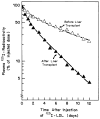Liver transplantation to provide low-density-lipoprotein receptors and lower plasma cholesterol in a child with homozygous familial hypercholesterolemia
- PMID: 6390206
- PMCID: PMC2975980
- DOI: 10.1056/NEJM198412273112603
Liver transplantation to provide low-density-lipoprotein receptors and lower plasma cholesterol in a child with homozygous familial hypercholesterolemia
Abstract
A six-year-old girl with severe hypercholesterolemia and atherosclerosis had two defective genes at the low-density-lipoprotein (LDL) receptor locus, as determined by biochemical studies of cultured fibroblasts. One gene, inherited from the mother, produced no LDL receptors; the other gene, inherited from the father, produced a receptor precursor that was not transported to the cell surface and was unable to bind LDL. The patient degraded intravenously administered 125I-LDL at an extremely low rate, indicating that her high plasma LDL-cholesterol level was caused by defective receptor-mediated removal of LDL from plasma. After transplantation of a liver and a heart from a normal donor, the patient's plasma LDL-cholesterol level declined by 81 per cent, from 988 to 184 mg per deciliter. The fractional catabolic rate for intravenously administered 125I-LDL, a measure of functional LDL receptors in vivo, increased by 2.5-fold. Thus, the transplanted liver, with its normal complement of LDL receptors, was able to remove LDL cholesterol from plasma at a nearly normal rate. We conclude that a genetically determined deficiency of LDL receptors can be largely reversed by liver transplantation. These data underscore the importance of hepatic LDL receptors in controlling the plasma level of LDL cholesterol in human beings.
Figures



References
-
- Goldstein JL, Kita T, Brown MS. Defective lipoprotein receptors and atherosclerosis: lessons from an animal counterpart of familial hypercholesterolemia. N Engl J Med. 1983;309:288–96. - PubMed
-
- Goldstein JL, Brown MS. Familial hypercholesterolemia. In: Stanbury JB, Wyngaarden JB, Fredrickson DS, Goldstein JL, Brown MS, editors. The metabolic basis of inherited disease. 5. New York: McGraw-Hill; 1983. pp. 672–712.
-
- Schneider WJ, Beisiegel U, Goldstein JL, Brown MS. Purification of the low density lipoprotein receptor, an acidic glycoprotein of 164,000 molecular weight. J Biol Chem. 1982;257:2664–73. - PubMed
-
- Yamamoto T, Davis CG, Brown MS, et al. The human LDL receptor: a cysteine-rich protein with multiple Alu sequences in its mRNA. Cell. 1984;39:27–38. - PubMed
Publication types
MeSH terms
Substances
Grants and funding
LinkOut - more resources
Full Text Sources
Other Literature Sources
Medical
